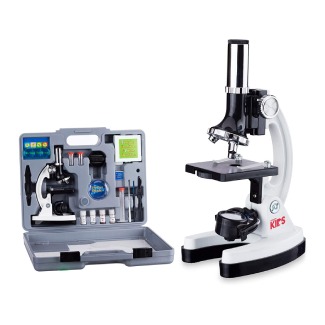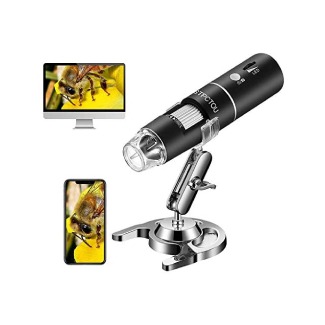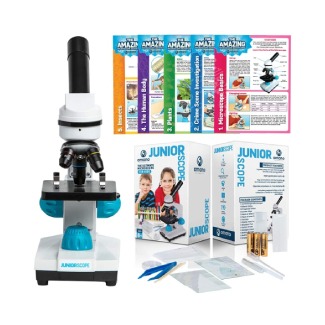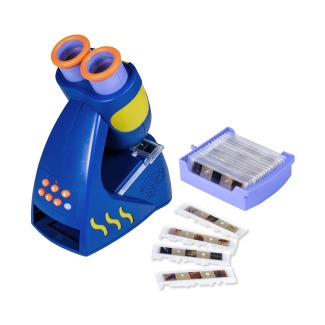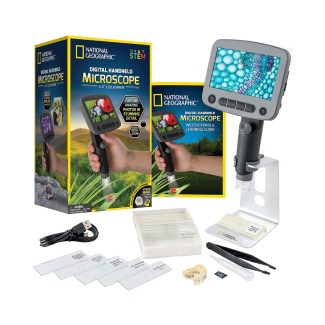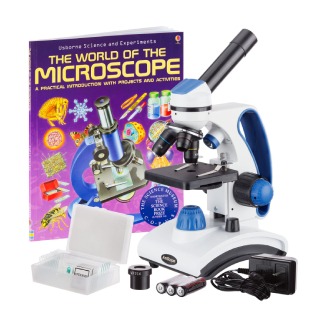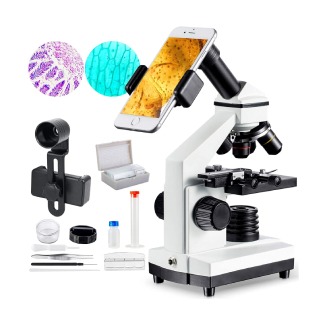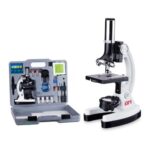The very first microscope was invented in 1590 by a Dutch eyeglass maker and his son, Zacharias and Han Jenssen. Their invention opened a whole new world to seeing things in a different manner. It also led to unlimited discoveries about plants, animals, and insects unlike anything we had seen in previous years. The compound microscope turned out to be a priceless invention that is still loved today. They are a wonderful way to teach our children fun ways to learn about science. Here are our top choices for kid-friendly microscopes.
7 Best Microscopes for Kids – Educational & Fun (2025 Reviews)
Best Microscopes for Kids
-
1. AmScope Kids Microscope STEM Kit
(Best classic set — $)
Why it’s great: This 52-piece set is similar to what us “old folks” had the privilege of using in school. The kit includes 7 blank slides, 5 prepared slides, tweezers, a petri dish, and 2 AA batteries for the LED light. Also included is a hard carrying case for simple storage. This easy-to-use microscope can be opened and put straight to work with little to no set up at all.
Keep in mind: Now a days this is considered a basic model and can not be synced or attached to a smartphone or other devices. Also, some parts are made of strong plastic, so if you are expecting solid metal this may not be the one for you.
Good for: Beginners who love to learn.
![AmScope Kids Microscope STEM Kit]()
-
2. Portable wireless digital microscope
(Best portable — $)
Why it’s great: This little guy comes fully equipped with WIFI capabilities, a camera, 8 LED lights, and it can even fit it in your pocket! You can connect to most smart devices and check things out while charging. A fully charged battery can last up to 3 hours, which is pretty good for a 5-inch-long portable microscope. Being able to connect to large screens can allow more in-depth viewing. This untraditional microscope does come with an adjustable metal stand that you can attach to for a more traditional use.
Keep in mind: Technology has come a long way, and even though this is user friendly, it could be too advanced for some.
Good for: On the go travels and exploring.
![Portable wireless digital microscope]()
-
3. JuniorScope Science Kit
(Best value — $$)
Why it’s great: This all-metal microscope is well built and easy to use. Beginner friendly but strong enough to long outlast all your future experimenting. This super package includes the normal, tweezers, blank and prepared slides, labels, test tubes, 3 AAA batteries and our favorite part, 5 informative cards full of adventures and experiments to get kids more involved. This is a solid kit and highly recommended.
Keep in mind: The manufacturer warning says this is meant for ages 6 and up. Some smaller pieces could be choking hazards. Children under 6 should always be well supervised.
Good for: A complete set intended for long term use.
![JuniorScope Science Kit]()
-
4. GeoSafari Playset
(Best toddler set — $)
Why it’s great: This adorable set is a great way to get the young ones interested in science early. A playful microscope with 20 prepared slides that even includes a fun set of binoculars for extra backyard exploration. This colorful set is lightweight and can keep toddlers busy discovering new things in a safe way.
Keep in mind: Obviously made of plastic and not meant to withstand rugged experimenting. This set is more pre-k based.
Good for: Improving toddlers hand eye coordination.
![GeoSafari Playset]()
-
5. National Geographic Digital Microscope
(Best trusted brand — $$)
Why it’s great: A lightweight but durable set that really thought of it all. This much more than a microscope has a 4.3 LCD screen, a rechargeable battery, and has 1080p full HD photo and video capabilities. It also includes a solid metal stand, micro-USB cable, micro-SD card, and easy-to-follow instruction guide. We love the multiple uses found for this microscope.
Keep in mind: Improving toddlers hand eye coordination.Improving toddlers hand eye coordination.Improving toddlers hand eye coordination.
Good for: Perfect traveling or hiking companion.
![National Geographic Digital Microscope]()
On An Important Side Note… Asher and I (pictured) feel it’s necessary to highlight the value of life insurance for parents with young kids. After extensive research, we discovered that parents can get insured for as little as $10 per month. We use Ladder Life who offers coverage up to $3M per parent (without a medical exam, just a few health questions) and you can apply 100% online.
Get a quote in less than 30 seconds at LadderLife.com ➜
-
6. AmScope M162 Micrscope
(Best upgraded — $$)
Why it’s great: This 2018 award winning microscope is all-metal and the perfect bundle for at home learning. The set includes blank and prepared slides with storage case, 3 AA batteries and adapter for dual lighting options, and an entire book full of information and experiments. It has adjustable eye and lens pieces that can rotate 360 degrees and both top and bottom lights can be individually set. This is a positive way to keep the kids busy for a while.
Keep in mind: This microscope has multiple settings and may take some time playing with the adjustments to get a perfectly clear view.
Good for: Long-term academic improvement.
![AmScope M162 Micrscope]()
-
7. Maxlapter Microscope
(Best quality — $$$)
Why it’s great: This wonderful combination is similar to a classic microscope with technology integrated for the best of both worlds. This microscope has the perk of separately controlled top and bottom LED lights with 8 brightness levels, along with fully adjustable lens and eye pieces. The full package also includes the standard accessories, instruction paper, phone mount, a carrying bag, and an adapter for plug-in or battery options. The mount allows you to see and save all you new discoveries right on your smartphone.
Keep in mind: We call this an instruction paper instead of a manual because it includes the basics but for real beginners you may need to do further research. Online help can be easily found, and anyone with some experience should not have a problem.
Good for: A wide range of ages and homeschooling projects
![Maxlapter Microscope]()
AmScope Kids Microscope STEM Kit
FAQs about Microscopes for Kids
-
1. Are microscopes safe for children to use?
Yes, most are safe and beneficial. Some microscopes include small pieces that are considered choking hazards, so kids under 3 should always be supervised. However, you can easily find toddler versions that are great for under 3.
-
2. At what age can my child start using a microscope?
In general, 3 to 4 years old is a great age to start exploring the science world and get kids involved. All children develop differently and of course, ages can vary.
-
3. What type of microscope should I buy?
We suggest starting kids with compound microscopes for a couple of reasons. Compound microscopes are the most common. They are also used in a majority of schools, so this will get children acclimated early.
-
4. What are the best things to look at under a microscope?
The options are endless, but we enjoy looking at household items like different salts and sugars. Our family has also had a lot of fun comparing strands of hair, different colors, and textures. Plants are great to explore, especially for our vegan families. Kids are normally pretty good at finding all kinds of things to inspect once you get them started.
-
5. Why are microscopes beneficial for children?
For younger children microscopes can be a great way to improve hand-eye coordination and get them interested in exploring. As the kids get older microscopes are great for brain stimulation, but also to get their creative minds really flowing. Microscopes give children of all ages an awesome grasp on S.T.E.M. (science, technology, engineering, math) learning and the realization that there is always more than meets the human eye.
Conclusion
As soon as we saw the microscopes in science class our curiosity was peaked. Our growing minds could not wait to see what was going on in the microscopic universe. There is a whole world of tiny organisms waiting to be explored. Microscopes are the perfect invention with endless benefits to our science communities. They have been around a long time and will continue to evolve over the years. No matter how old you are, what you are looking at, or which microscope you use, it is always easy to be surprised by what you can find. We hope this was helpful and you can find the microscope just right for you!




